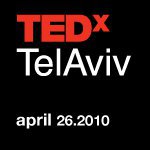Just got out of the third session, and only have a few minutes until the next one. So, here’s a quick rehash of the third session, and your third update.


Dave Levy, from Snowball animation, shared a clip, with some behind the scenes material, from their new project/film “Fragball.” But here’s what’s cool – it’s a 3D animation that looks almost real. They create a character and virtual set in a 3D model which imitates live action sets. Its pretty cool. Check it out. You can probably find it in by Google-ing.
Shimon Schocken – “The Science of Rehabilitation”
One of the founders of the IDC, Professor Schoken, who retired from his tenured position at NYU to return to Israel, is passionate about mountain biking. Through mountain biking, he is able to connect to the “profound beauty” and history of Israel. He finds it extremely empowering. About four years ago, he started a mountain biking club at a juvenile delinquent facility (or state prison for younger inmates). He rides with 10 kids, once a week, showing them Israel, nature, animals, etc. In the beginning, he found that the kids became easily frustrated, having temper tantrums, with little or no anger control. In response, he found that the best way to help the kids through it was to stay close, pet the kids head, use soft words, and give them some chocolate; in other words, provide the kids the with “unconditional acceptance” that they had never had. His vision, when he first started the program, had been to create a team of underdogs. Quickly, however, that vision changed. It became his goal to show the kids love – love of the country, the ride, the creatures, their fellow teammates, and of their selves. This changed his world understanding from one of logic and optimization to one of empathy and flexibility. As he put it, it merged into a situation in which he says “These are my principles. If you don’t like them, I have others.” His principles are focus, endurance, teamwork, and perspective. Through them, he believes one can develop self esteem and learn to love one’s self. He takes the kids to visit kibbutzim established by Holocaust survivors, ruins of Palestinian villages, ancient Cannanite and Nabatean settlements, etc. His goal in that is to teach the kids that like is complex; not black and white, but shades of gray. Through an understanding that life is complex, tolerence can emerge, and through tolerance, hope. He invites people to join him on his rides, every Tuesday, with the kids.
Isaac “Itzik” Berzin – “Fill It Up With Seaweed”
[This was AWESOME!!!]
Itzik Berzin is a chemical engineer, who argues that we can solve three of the world’s largest problems with one simply solution. The problems are these: 1 – carbon emission; coal plants seriously pollute the air, yet we “need” them for fuel. 2 – oil; oil increases global warming, and also, has the problem that it comes from countries which, as he says, “are not so strong in democracy,”). 3 – food sustainability; humankind has killed off all the little fish to feed big fish. But, we need to little fish because they have Omega 3.
What’s the simple little solution? ALGAE!
Algae is responsible for half of the oxygen we breath. They are “champions” of photosynthesis, doubling in mass every few hours, don’t require land, and grow like crazy in a carbon dioxide rich environment. They are the natural platform to deal with carbon emissions. (Plus, its a way better method than trying to hid large bubbles of highly concentrated CO2 in some cavern somewhere which can burst out and flow like a wave of death to a nearby city). Problem 1 – solved.
Oil comes from algae, compressed over millions of years. So, you can make fuel out of algae. This would allow the world to keep its existing oil-based infrastructure intact, yet avoid drilling for oil which pollutes the air (and props up scary dictatorships). Problem 2 -solved.
Small fish get Omega 3 how? By eating algae. So, skip the middle man. We can extract Omega 3 directly from the algae. Problem 3 -solved.
So why isn’t algae being mass produced? Algae, today, is grown for the rich. SO how do you bring down the price? Well, the Arizona power plant, for one, has created an algae farm (thanks to some encouragement from Berzin). Here’s the thing – energy is big. A single corn field that can support ethanol facilities is 100 square acres in size. Also, the energy balance (i.e. what you get out minus what you put in) must be positive. Third, energy must make money (i.e. it must be economically viable). Energy crops already exist. In Brazil they’ve begun to make it out of sugar; in the U.S., out of corn. The problem is, that we eat sugar and corn. Renewable energy shouldn’t mean that some people starve. There’s a solution though – we don’t eat algae. Therefore, we should be using algae for our fuel. Oil, in the future, will be cultured from algae, not drilled. Also, you shouldn’t be growing your fuel places where you grow your food. So where? The desert. Israel has become a master at this. Israel is the leader of culturing things in the desert, and is number one in the words in recycling its water (Israel recycles 70%. Spain, at #2, recycles 12).
There’s more from this session, but session four is starting, so look later for update 3.5
- ileaרn - 10/16/2010
- Wrap Up - 9/16/2010
- ICT Conference Summary of New Media Session - 9/16/2010




